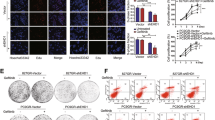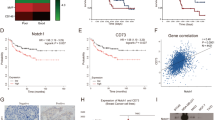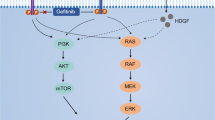Abstract
We have shown that one of the principle mechanisms of chemotherapy resistance involves the activation of nuclear factor kappa-B (NF-κB). In an effort to identify NF-κB-regulated chemotherapy response genes, we performed a microarray assay and observed that heparin-binding EGF-like growth factor (HB-EGF) was significantly upregulated by SN38 (a strong inducer of NF-κB activity) in colon cancer cells. Further studies revealed that HB-EGF was rapidly induced following a variety of chemotherapy treatments. Using RNA interference, we demonstrated that the chemotherapy-induced HB-EGF was largely dependent on activator protein-1 (AP-1) and NF-κB activation. Constitutive HB-EGF expression rescued AP-1/NF-κB small interfering RNA (siRNA) cells from chemotherapy-induced apoptosis. Meanwhile, we found that the enzymatic shedding of HB-EGF was also regulated by chemotherapy treatment, resulting in the elevated release of soluble HB-EGF from the cellular membrane. Induction of HB-EGF expression and ectodomain shedding synergistically led to robust epidermal growth factor receptor (EGFR) phosphorylation, whereas inhibition of HB-EGF expression by use of the HB-EGF inhibitor (CRM197) or siRNA resulted in the suppression of chemotherapy-induced EGFR phosphorylation. These results suggest that the chemotherapy-induced EGFR activation is regulated by HB-EGF. Finally, we demonstrated that overexpression of HB-EGF led to apoptotic resistance to chemotherapy, whereas suppression of HB-EGF expression by siRNA resulted in a dramatic increase in cell death. In summary, our study suggests that chemotherapy-induced HB-EGF activation represents a critical mechanism of inducible chemotherapy resistance. Therefore, therapeutic intervention aimed at inhibiting HB-EGF activity may be useful in cancer prevention and treatments.
This is a preview of subscription content, access via your institution
Access options
Subscribe to this journal
Receive 50 print issues and online access
$259.00 per year
only $5.18 per issue
Buy this article
- Purchase on Springer Link
- Instant access to full article PDF
Prices may be subject to local taxes which are calculated during checkout








Similar content being viewed by others
References
Armant DR, Kilburn BA, Petkova A, Edwin SS, Duniec-Dmuchowski ZM, Edwards HJ et al. (2006). Human trophoblast survival at low oxygen concentrations requires metalloproteinase-mediated shedding of heparin-binding EGF-like growth factor. Development 133: 751–759.
Asakura M, Kitakaze M, Takashima S, Liao Y, Ishikura F, Yoshinaka T et al. (2002). Cardiac hypertrophy is inhibited by antagonism of ADAM12 processing of HB-EGF: metalloproteinase inhibitors as a new therapy. Nat Med 8: 35–40.
Bode AM, Dong Z . (2004). Targeting signal transduction pathways by chemopreventive agents. Mutat Res 555: 33–51.
Cusack JC, Liu R, Baldwin AS . (1999). NF-kappa B and chemoresistance: potentiation of cancer drugs via inhibition of NF-kappa B. Drug Resist Update 2: 271–273.
Cusack Jr JC, Liu R, Houston M, Abendroth K, Elliott PJ, Adams J et al. (2001). Enhanced chemosensitivity to CPT-11 with proteasome inhibitor PS-341: implications for systemic nuclear factor-kappaB inhibition. Cancer Res 61: 3535–3540.
Fang L, Li G, Liu G, Lee SW, Aaronson SA . (2001). p53 induction of heparin-binding EGF-like growth factor counteracts p53 growth suppression through activation of MAPK and PI3K/Akt signaling cascades. EMBO J 20: 1931–1939.
Higashiyama S, Nanba D . (2005). ADAM-mediated ectodomain shedding of HB-EGF in receptor cross-talk. Biochim Biophys Acta 1751: 110–117.
Hirata M, Umata T, Takahashi T, Ohnuma M, Miura Y, Iwamoto R et al. (2001). Identification of serum factor inducing ectodomain shedding of proHB-EGF and sStudies of noncleavable mutants of proHB-EGF. Biochem Biophys Res Commun 283: 915–922.
Ito Y, Higashiyama S, Takeda T, Yamamoto Y, Wakasa KI, Matsuura N . (2001a). Expression of heparin-binding epidermal growth factor-like growth factor in pancreatic adenocarcinoma. Int J Pancreatol 29: 47–52.
Ito Y, Takeda T, Higashiyama S, Sakon M, Wakasa KI, Tsujimoto M et al. (2001b). Expression of heparin binding epidermal growth factor-like growth factor in hepatocellular carcinoma: an immunohistochemical study. Oncol Rep 8: 903–907.
Itoh Y, Joh T, Tanida S, Sasaki M, Kataoka H, Itoh K et al. (2005). IL-8 promotes cell proliferation and migration through metalloproteinase-cleavage proHB-EGF in human colon carcinoma cells. Cytokine 29: 275–282.
Kanda N, Watanabe S . (2005). 17beta-estradiol enhances heparin-binding epidermal growth factor-like growth factor production in human keratinocytes. Am J Physiol Cell Physiol 288: C813–C823.
Kishida O, Miyazaki Y, Murayama Y, Ogasa M, Miyazaki T, Yamamoto T et al. (2005). Gefitinib (‘Iressa’, ZD1839) inhibits SN38-triggered EGF signals and IL-8 production in gastric cancer cells. Cancer Chemother Pharmacol 55: 393–403.
Miyamoto S, Hirata M, Yamazaki A, Kageyama T, Hasuwa H, Mizushima H et al. (2004). Heparin-binding EGF-like growth factor is a promising target for ovarian cancer therapy. Cancer Res 64: 5720–5727.
Nakanishi C, Toi M . (2005). Nuclear factor-kappaB inhibitors as sensitizers to anticancer drugs. Nat Rev Cancer 5: 297–309.
Nishi E, Klagsbrun M . (2004). Heparin-binding epidermal growth factor-like growth factor (HB-EGF) is a mediator of multiple physiological and pathological pathways. Growth Factors 22: 253–260.
Ongusaha PP, Kwak JC, Zwible AJ, Macip S, Higashiyama S, Taniguchi N et al. (2004). HB-EGF is a potent inducer of tumor growth and angiogenesis. Cancer Res 64: 5283–5290.
Park JM, Adam RM, Peters CA, Guthrie PD, Sun Z, Klagsbrun M et al. (1999). AP-1 mediates stretch-induced expression of HB-EGF in bladder smooth muscle cells. Am J Physiol 277: C294–C301.
Prenzel N, Zwick E, Daub H, Leserer M, Abraham R, Wallasch C et al. (1999). EGF receptor transactivation by G-protein-coupled receptors requires metalloproteinase cleavage of proHB-EGF. Nature 402: 884–888.
Russo SM, Tepper JE, Baldwin Jr AS, Liu R, Adams J, Elliott P et al. (2001). Enhancement of radiosensitivity by proteasome inhibition: implications for a role of NF-kappaB. Int J Radiat Oncol Biol Phys 50: 183–193.
Suganuma K, Kubota T, Saikawa Y, Abe S, Otani Y, Furukawa T et al. (2003). Possible chemoresistance-related genes for gastric cancer detected by cDNA microarray. Cancer Sci 94: 355–359.
Takenobu H, Yamazaki A, Hirata M, Umata T, Mekada E . (2003). The stress- and inflammatory cytokine-induced ectodomain shedding of heparin-binding epidermal growth factor-like growth factor is mediated by p38 MAPK, distinct from the 12-O-tetradecanoylphorbol-13-acetate- and lysophosphatidic acid-induced signaling cascades. J Biol Chem 278: 17255–17262.
Wang CY, Cusack Jr JC, Liu R, Baldwin Jr AS . (1999). Control of inducible chemoresistance: enhanced anti-tumor therapy through increased apoptosis by inhibition of NF-kappaB. Nat Med 5: 412–417.
Xu KP, Ding Y, Ling J, Dong Z, Yu FS . (2004). Wound-induced HB-EGF ectodomain shedding and EGFR activation in corneal epithelial cells. Invest Ophthalmol Vis Sci 45: 813–820.
Yang X, Zhu MJ, Sreejayan N, Ren J, Du M . (2005). Angiotensin II promotes smooth muscle cell proliferation and migration through release of heparin-binding epidermal growth factor and activation of EGF-receptor pathway. Mol Cells 20: 263–270.
Yemelyanov A, Gasparian A, Lindholm P, Dang L, Pierce JW, Kisseljov F et al. (2006). Effects of IKK inhibitor PS1145 on NF-kappaB function, proliferation, apoptosis and invasion activity in prostate carcinoma cells. Oncogene 25: 387–398.
Acknowledgements
This study was supported by NIH grant support CA77278-01A1 and CA98871-01 (J Cusack).
Author information
Authors and Affiliations
Corresponding author
Rights and permissions
About this article
Cite this article
Wang, F., Liu, R., Lee, S. et al. Heparin-binding EGF-like growth factor is an early response gene to chemotherapy and contributes to chemotherapy resistance. Oncogene 26, 2006–2016 (2007). https://doi.org/10.1038/sj.onc.1209999
Received:
Revised:
Accepted:
Published:
Issue Date:
DOI: https://doi.org/10.1038/sj.onc.1209999
Keywords
This article is cited by
-
Adaptive resistance to lorlatinib via EGFR signaling in ALK-rearranged lung cancer
npj Precision Oncology (2023)
-
E6-mediated activation of JNK drives EGFR signalling to promote proliferation and viral oncoprotein expression in cervical cancer
Cell Death & Differentiation (2021)
-
First-in-human study of the anti-HB-EGF antibody U3-1565 in subjects with advanced solid tumors
Investigational New Drugs (2019)
-
BK-UM in patients with recurrent ovarian cancer or peritoneal cancer: a first-in-human phase-I study
BMC Cancer (2017)
-
Phase 1 Study of Monotherapy with KHK2866, an Anti-Heparin-Binding Epidermal Growth Factor-Like Growth Factor Monoclonal Antibody, in Patients with Advanced Cancer
Targeted Oncology (2016)



